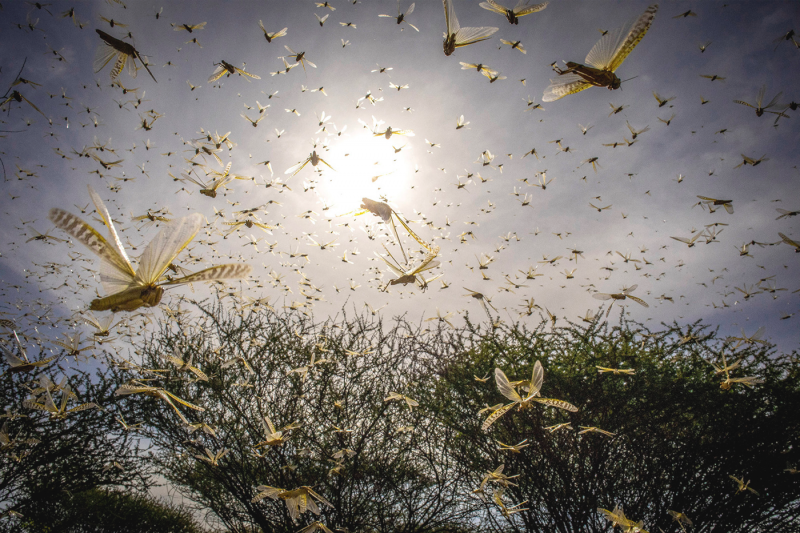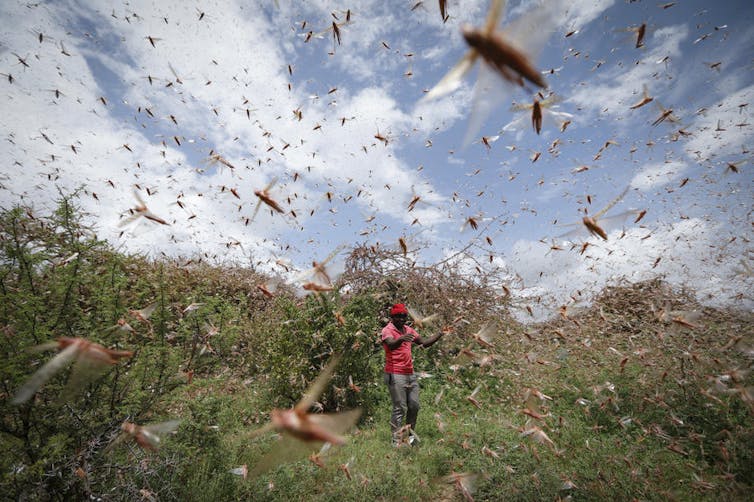 “This is an unprecedented situation that we are facing,” said Dominique Burgeon, an emergency services director at the U.N. Food and Agriculture Organization.
“This is an unprecedented situation that we are facing,” said Dominique Burgeon, an emergency services director at the U.N. Food and Agriculture Organization.
The UN says the swarms are the largest in Somalia and Ethiopia in 25 years. Meanwhile, neighbouring Kenya has not seen a locust threat as severe in 70 years, according to the UN Food and Agriculture Organization (FAO).
U.N. Secretary-General António Guterres pinned blame for the crisis squarely on global warming. “Desert locusts are extremely dangerous,” Guterres wrote. “Triggered by the climate crisis, the outbreak is making the dire food security situation in East Africa even worse.”
The desert locust is a particularly ravenous species that can eat its own weight in food every day. Swarms easily consume entire fields and form mass clouds large enough to block out the sun. They’re quick, too—moving up to 150 kilometers in a day.
“It’s certainly the most dangerous migratory pest in the world, desert locust,” said Keith Cressman, FAO’s senior agriculture officer. “A swarm the size of Rome can eat enough food in one day as everybody in Kenya.”
The Food and Agriculture Organisation (FAO) has warned that the locust invasion in the Horn of Africa may soon spread to other countries. The locusts feeding on crops could leave millions of people without food. Cyril Piou shares his insights on where they might go and how countries should prepare.
What triggered this locust invasion and its geographical spread?
Locusts are capable of going from a solitarious form – where they act as a solitary individual – when there’s not many of them to the swarming devastating gregarious form – where they develop group behaviour and act in unison – when there are many of them. This is called gregarisation. The change towards gregarious behaviour is triggered by physical contact and they then become inclined to disperse together to find food.
The current invasion of desert locust originated along the Red Sea, in Yemen and Oman, during the 2018 to 2019 winter. The rains, brought by the October 2018 cyclone Luban, produced areas full of vegetation where the locusts could feed, breed and become gregarious.
From January 2019, small swarms spread in the Arab Peninsula, along the Red Sea and even reached Iran and Pakistan. Other swarms stayed in the Arab Peninsula where they reproduced and multiplied.
In June, the locusts crossed the Red Sea or the Gulf of Aden, which is just a few hours of flight for the locusts, and started to spread into the Horn of Africa. They invaded the North of Somalia and Ethiopia where floods in October and November created good conditions for desert locust to continue to multiply. The large swarms that have invaded Kenya since December are a result of this.
What damage has this invasion caused along its path?
So far, the FAO hasn’t done a precise evaluation of the damaged caused by the swarms. However, the situation has been serious in the region for a few months now and more than 5000 km² of crops are known to have been affected in the Horn of Africa. The precise situation is hard to evaluate in some countries, like Somalia, where warnings appeared already in October 2019.
As a rough estimate, a swarm of one billion insects covers approximately 20km² and will eat 2000 metric tons of vegetation each day. In the past few weeks, parts of Kenya have received swarms that cover more than 100km², so their feeding will have been devastating.
The organisation of a coordinated and rapid response in the coming weeks is vital to avoid that damage spread to other countries. The FAO has called for US$70 million to organise the anti-locust campaign.
Worst locust invasion to hit East Africa in 25 years grounds Ethiopia Airlines jet, which was a spattered mess with damaged engines after flying through swarm. Crops hit hard, with UN teams warning of food shortages. Locusts number 40million per sq km in some parts of East Africa pic.twitter.com/Ka4bReoUw6
— James Hall (@hallaboutafrica) January 15, 2020
What are the best ways of dealing with them and are affected countries equipped?
The best way of dealing with desert locust, as other locust species, is to adopt a preventive management strategy. The idea behind this is to find areas where solitarious individuals meet and start the gregarisation process and spray the locusts before they create swarms. Chemical pesticides are often used, but biopesticides also exist and should be used as they’re less harmful to people and the environment.
Read more:
Lessons on how to effectively tackle insect invasions
Ground teams need to do regular surveys to find areas where gregarisation may be happening. This typically takes place in semi-arid areas that have received good rains, allowing vegetation to grow.
There are satellite and computer modelling tools that can help to orient the ground teams.
My colleagues and I have done research that uses soil moisture to forecast the presence of locusts. Vegetation will start to appear in semi-arid areas after rain, when the soil is more moist. By remotely monitoring soil moisture, we can give three to four weeks more advance warning than when just observing vegetation. If some areas are considered as potentially interesting for locust development, field teams should visit them.
The countries of the Arab peninsula, the western coast of the Red Sea and Ethiopia are part of a regional locust commission of the FAO and cooperate to train their survey teams and use up-to-date technology to collect and manage field information for preventive management.
But not all countries have preventive strategies in place. Countries suffering from civil war and political instability are often unable to properly carry out preventive control activities. They are also less able to react quickly when swarms arrive from neighbouring countries.
Another recurrent problem of preventive management is that the issue is often forgotten when not dealt with for a long time, hence creating invasions in cycles. When big invasions occur, lots of human and technical support is used to fight the locusts. A preventive management system is usually then set in place. But countries eventually forget about locusts and gradually decrease their prevention efforts.
For the countries already affected by the swarms, in this case, it’s too late for prevention. The swarms are spreading, and given the size of the problem, unfortunately airplanes must spray insecticides over large areas to control them.
 A man chases away a swarm of desert locusts in the bush near Enziu, Kitui County, some 200km east of the capital Nairobi, Kenya. DAI KUROKAWA/EPA
A man chases away a swarm of desert locusts in the bush near Enziu, Kitui County, some 200km east of the capital Nairobi, Kenya. DAI KUROKAWA/EPA
Which countries are now at risk and why?
The countries of the Horn of Africa – Djibouti, Eritrea, Somalia, Ethiopia and Kenya – are the most at risk now. The swarms may continue to breed and multiply, destroying even more the crops. In the coming months, if control actions aren’t successful, the swarms could spread to Uganda or South Sudan and eventually other more western countries, depending on wind directions.
In the past, large plagues of desert locust spread all the way south to Tanzania and many countries of central Africa. International cooperation is essential to help countries currently under attack and avoid its spread. The FAO is currently trying to coordinate this.
How should countries prepare for the invasion?
Now that swarms are rolling in, countries need to have a control institution in place to coordinate activities and information to track, locate and eliminate swarms and hopper bands (when locusts are still without wings) as early as possible. Again, when available and possible, biopesticides should be used over chemical ones.
The countries that don’t have a proper preventive management system in place should rely on the expertise of countries that do, like the exemplary ones in Western Africa. Mauritania for example, despite its economic difficulties, has managed to build an anti-locust centre that sends dozens of field teams out every year to look for early signs of gregarisation. They spray an average of about 20 000 ha per year for prevention.
It’s particularly important that people are trained in spraying techniques to avoid having too many negative environmental and human health impacts.![]()
Cyril Piou, Scientist, Cirad
This article is republished from The Conversation under a Creative Commons license. Read the original article.





 B
B
19 Comments
Pingback: relaxing music sleep
Pingback: self care
Pingback: deadwood tobacco
Pingback: Demo Slot PG
Pingback: blue magnolia rust mushroom
Pingback: ozempic coupon
Pingback: bear compound bow
Pingback: บับเบิ้ล
Pingback: dultogel
Pingback: i loved this
Pingback: UFAPIG Login
Pingback: รวมเว็บพนันออนไลน์
Pingback: fortnite hacks
Pingback: One day Phi Phi islands Trip from Phuket
Pingback: pop over here
Pingback: unieke reizen
Pingback: เกมสล็อตแจ็คพ็อตแตกบ่อย Rich88 Slot
Pingback: Telegram中文
Pingback: DK780 ทางเข้าคาสิโนออนไลน์เว็บตรง